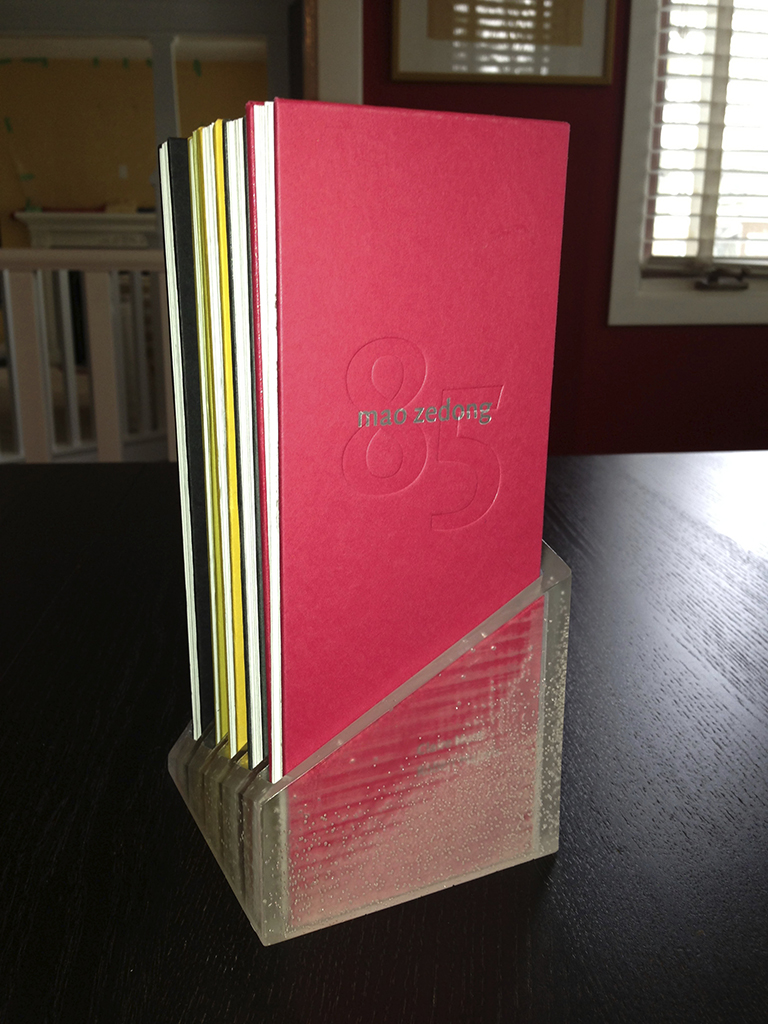
Window into the Tang Dynasty
Claire Huot and Robert Majzels
+15 Window Exhibition
February 4 to April 5, 2014
Window into the Tang Dynasty is an exploration in the ways we receive another language and culture into our own. The visual texts, printed on hand-made xuan paper, hanging in The New Gallery’s +15 Window are translations into English of Chinese poems dating back to the Tang dynasty (7th-10th C.E.). Each poem contains 85 letters, printed without space breaks or punctuation and reading from right to left and top to bottom in the Chinese tradition. The texts floating in the window invite the viewer’s active engagement in the translation process. The reader experiences the search for meaning, as he or she organizes the letters into fluctuating combinations of meaning.
The formal inspiration for the work comes from the ancient biblical texts dating back to the origins of Western civilization, which contain no punctuation or spaces between the letters. The constraint of 85 letters is based on the Talmudic definition of a book as a minimum of 85 letters in which meaning is in continual movement. Coincidentally, the formal constraint of 85 letters is also akin to the morpho-syllabic process of constructing meanings with shifting semantic kernels of the Chinese language. Hence, a formal constraint based on an ancient Western textual practice to stage an encounter with the Chinese culture and language.
The artists have applied variations on the same constraint to different series of works and published them in a special edition artist’s book, housed in a dock produced by Nathan Tremblay and presented here as part of the exhibition.



Biographies
Claire Huot is a sinologist, academic, and artist. She has been engaged in the study of Chinese language and culture since the late 1970s. She is fluent in spoken Mandarin and written Chinese and has spent several year-long periods of time studying and working in China. She holds a Ph.D. from the Université de Montréal with a thesis on the theory and translation of Chinese calligraphy (1987). She has taught and written extensively about Chinese contemporary film, visual arts, and literature. She served as Canada’s Cultural Counselor in the People’s Republic of China in 2000–2002. In addition to her work on the 85 Project, she has published a critical book entitled China’s New Cultural Scene (Duke University Press, 2000), and a novel entitled The Prison Tangram (Mercury Press, 2006). She is presently an Associate Professor of Chinese Studies at the University of Calgary.
Robert Majzels is a writer whose work defies categories. He has experimented with the established genres in poetry, fiction and drama. He has translated several books of poetry and fiction from French into English and won several prizes including the Governor General’s Award for Translation. His earliest work already highlighted the materiality of language, pasting newspaper clippings into his first novel, Hellman’s Scrapbook, for example. His novel Apikoros Sleuth adopts the dynamic and polyvocal form of the Talmud, with a central column of text surrounded by other columns and annotations. In 2007, he won the Alcuin Society Prize for Excellence in Book Design for the limited edition of Apikoros Sleuth. From 2000 to 2002, Robert lived in Beijing, China, where he studied Mandarin Chinese. With the 85 Project, he has furthered his experiments on the visual and cross-cultural powers of language. He was an Associate Professor in English at the University of Calgary until 2014.
Nathan Tremblay is a visual artist with a Masters degree in Computational Media Design from the University of Calgary. He is the principal Director / Designer for Palette Industries (www.paletteindustries.com), a multi-disciplinary design firm located in Calgary, AB, Canada. Palette strives to construct unique situations that explore the intrinsic nature of our own embedded narratives, personally and communally, creating a continuously evolving dialogue between the object, the individual and the environment.
